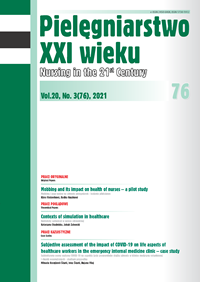Objective structured clinical examination in fundamentals of nursing and obstetric care as method of verification and assessing the degree of achievement of learning outcomes
DOI:
https://doi.org/10.2478/pielxxiw-2021-0026Keywords:
students, education, nursing, midwifery, OSCE examAbstract
OBJECTIVE STRUCTURED CLINICAL EXAMINATION IN FUNDAMENTALS OF NURSING AND OBSTETRIC CARE AS METHOD OF VERIFICATION AND ASSESSING THE DEGREE OF ACHIEVEMENT OF LEARNING OUTCOMES
Aim. The aim of the study was (1) to assess the degree of preparedness of nursing and midwifery students for OSCE-type examinations (Objective Structured Clinical Examination), (2) to learn the opinions of students regarding examination in the form of the OSCE and (3) to learn about the emotions which accompany the examination.
Material and methods. The number of 160 (53.33%) nursing students and 140 (46.67%) midwifery students from 5 medical universities were studied. The diagnostic survey method and survey techniques were applied. An own questionnaire was used.
Results. Students were the best prepared to perform hygienic and nursing procedures (M=4.22, SD=0.85) and the least prepared to perform gastrointestinal procedures (M=3.03, SD=1.24). The majority (237/79%) claimed that the OSCE examiners should be lecturers from their home university. High marks were given to the quantity and quality of equipment prepared for the examination (232/77.34%) and knowledge of the rules and procedure of conducting the examination (226/75.33%). The OSCE examination was accompanied by high levels of stress (M=4.64, SD=0.78) and fear of making a mistake (M=4.54, SD=0.75). One of the lowest rated aspects of the OSCE exam by students was the time allocated to completing tasks (M=2.96, SD=1.21).
Conclusions. Because students rated low the time allocated to the tasks, the lecturers organizing the examination in the future should pay more attention to this aspect. From the very first semester, it is worth considering the introduction of classes in nursing and midwifery aimed at teaching effective ways of coping with stress.
References
1. Rozporządzenie Ministra Nauki i Szkolnictwa Wyższego z dnia 26 lipca 2019 r . w sprawie standardów kształcenia przygotowującego do wykonywania zawodu lekarza, lekarza dentysty, farmaceuty, pielęgniarki, położnej, diagnosty laboratoryjnego, fizjoterapeuty, ratownika medycznego. [serial online] [cited 2020 Nov 13]. Available from URL: https://isap.sejm.gov.pl/isap.nsf/DocDetails.xsp?id=WDU20190001573.
2. Uchwała nr 103/IV/2017 z dnia 22 czerwca 2017 w sprawie realizacji zajęć dydaktycznych w Centrach Symulacji Medycznej wielo – i monoprofilowych na kierunku pielęgniarstwo i kierunku położnictwo. [serial online] [cited 2020 Nov 13] Available from URL: https://www.gov.pl/web/zdrowie/krajowa-radaakredytacyjna-szkol-pielegniarek-i-poloznych-kraszpip-
3. Torres K, Kański A. red. Symulacja w edukacji medycznej. Lublin: MediQ; 2018.
4. Hemingway S, Stephenson J, Roberts B, et al. Mental health and learning disability nursing students’ perceptions of the usefulness of the objective structured clinical examination to assess their competence in medicine administration. Int. J. Ment. Health Nurs. 2014; 23(4): 364-373.
5. Goh HS, Zhang H, Lee CN, et al. Value of Nursing Objective Structured Clinical Examinations: A Scoping Review. Nurse Educ. 2019; 44(5): E1-E6.
6. Panczyk M, Gałązkowski R, Gotlib J. Wykorzystanie symulacji do oceny umiejętności technicznych studentów medycyny i ratownictwa medycznego: aktualny przegląd badań. Anestezjol. Rat. 2016; 10(2): 184-193.
7. Szeliga M, Kuźmicz I, Skrzypek A, et al. Ocena kompetencji klinicznych przyszłych lekarzy i pielęgniarek: tradycyjny egzamin kliniczny i OSCE. Polish J. Cont. Educ. 2016; 3: 112-119.
8. Nunnally JC. red. Psychometric Theory, 2nd ed. New York: McGraw-Hill; 1978.
9. Cook DA, Hatala R, Zendejas B, et al. Technology-enhanced simulation for health professions education: a systematic review and meta-analysis. JAMA. 2011; 7(306): 978-988.
10. Kamińska A, Majda A, Ogórek-Tęcza B, et al. Nowe metody oceny umiejętności praktycznych studentów pielęgniarstwa. Pielęgniarstwo XXI wieku. 2014; 2(47): 5-9.
11. Skrzypek A, Szeliga M, Stalmach-Przygoda A, et al. The Objective Structured Clinical Examination (OSCE) from the perspective of 3rd year’s medical students – a pilot study. Folia Medica Cracoviensia. 2017; 8(3): 67-75.
12. Karol DL, Pugh D. Potential of feedback during objective structured clinical examination to evoke an emotional response in medical students in Canada. J Educ Eval Health Prof. 2020; 17: 5.
13. Nasir AA, Yusuf AS, Abdur-Rahman LO, et al. Medical students’ perception of objective structured clinical examination: a feedback for process improvement. J Surg Educ. 2014; 71(5): 701-706.
14. Zhang N, Walton DM. Why So Stressed? A Descriptive Thematic Analysis of Physical Therapy Students’ Descriptions of Causes of Anxiety during Objective Structured Clinical Exams. Physiotherapy Canada. 2018; 70(4): 356-362.
Downloads
Published
Issue
Section
License
Copyright (c) 2021 Authors

This work is licensed under a Creative Commons Attribution-NonCommercial-NoDerivatives 4.0 International License.




